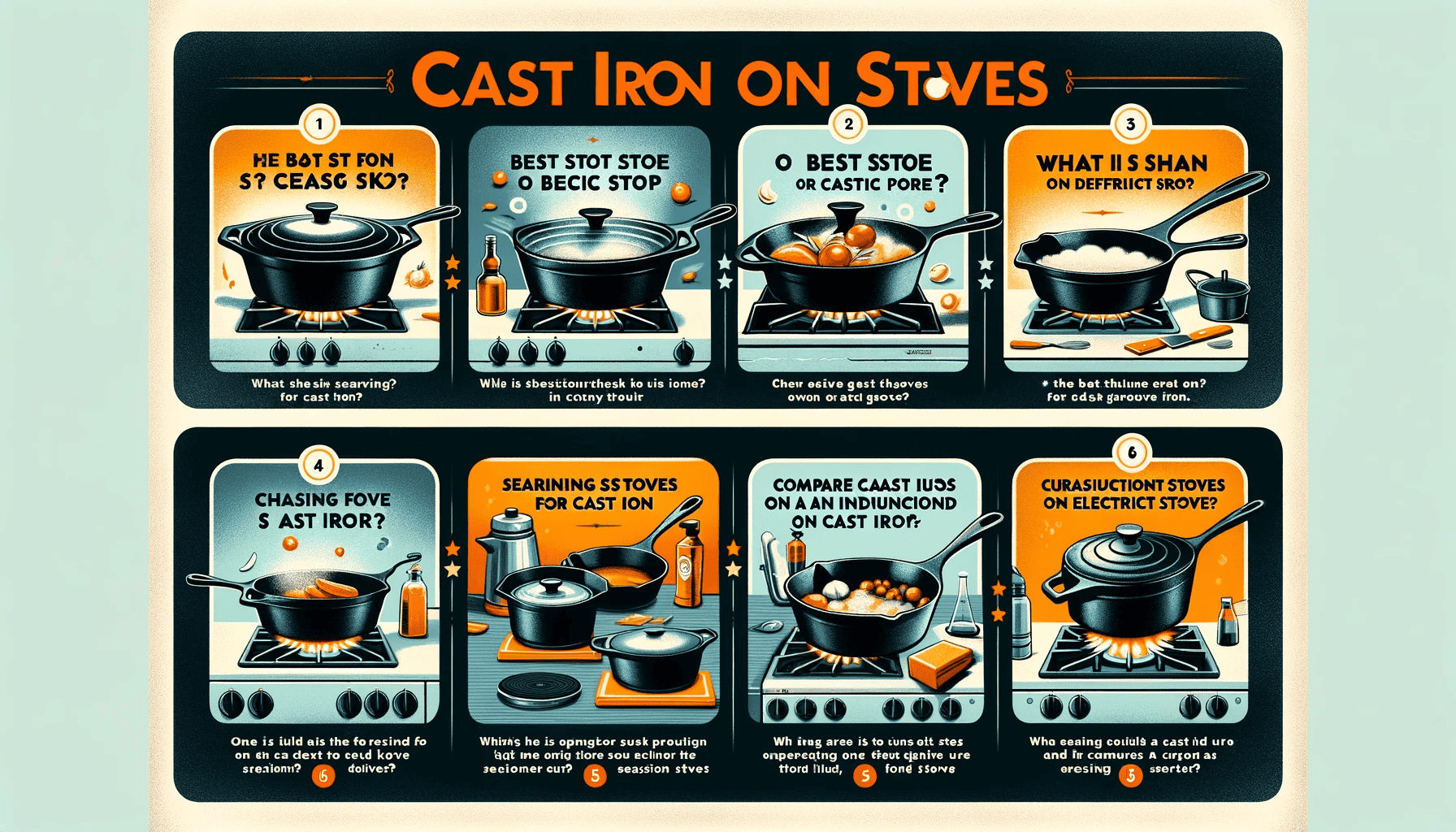When it comes to finding the best stoves for cast iron, there are several key factors to consider. Cast iron cookware is renowned for its excellent heat retention and durability, making it a favorite among both professional chefs and home cooks.
However, to get the most out of your cast iron pans, you need a stove that can match its demands. The perfect stove should offer consistent heat distribution, be made of durable materials, and provide precise temperature control.
It’s also crucial to consider the stove design, especially how well it accommodates the weight and size of cast iron pans.
The type of burner is another important aspect.
For cast iron, gas burners with flame control or electric stoves with smooth cooking surfaces are often preferred. These types allow for even cooking and are easier to manage.
Energy efficiency is another trending criterion, as more people look for ways to reduce their carbon footprint while cooking. A stove that’s energy-efficient not only benefits the environment but can also help reduce utility bills in the long run.
Stoves that are easy to clean (think cleaning ease) and have useful safety features add an extra layer of convenience and security, which is especially important in busy kitchens.
However, it’s not just about functionality; the stove’s design and material can significantly impact your kitchen’s overall aesthetic. A beautifully designed stove can serve as a focal point in your kitchen, enhancing its appearance.
Plus, considering the stove size and fuel type (like gas, electric, or induction) ensures that the stove fits well in your kitchen and meets your cooking needs. Ultimately, the best stove for cast iron is one that balances performance, efficiency, and style, making your cooking experience both enjoyable and effective.
< class="wp-block-separator has-alpha-channel-opacity"/>Unveiling the Gas Stove: A Culinary Enthusiast’s Delight
Gas stoves, often seen as the heart of a culinary enthusiast’s kitchen, excel in offering unparalleled control over the cooking process.
This control is particularly crucial when using cast iron cookware, where managing the heat can mean the difference between a perfectly seared steak and a burnt one. Let’s delve into why gas stoves are a top choice for those who love cooking with cast iron.
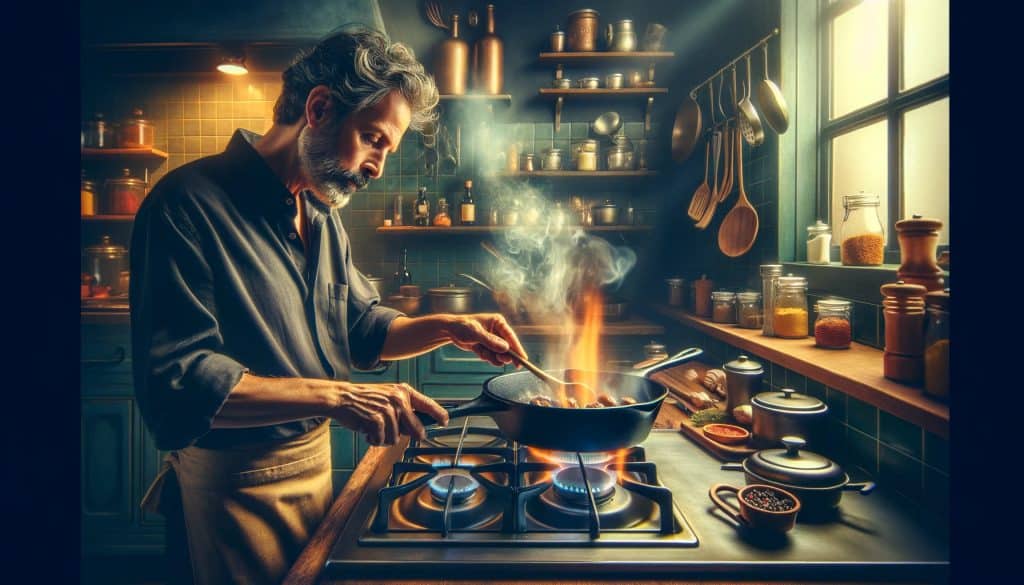
Precision and Responsiveness
One of the greatest advantages of a gas stove is its responsiveness. You can adjust the flame and see the effect on your cooking instantly. This feature is particularly beneficial for recipes that require quick changes in temperature.
For example, when searing meat in a cast iron skillet, you need high heat to start, but then a lower temperature to continue cooking without burning.
Temperature Control on Gas Stoves
| Cooking Technique | Flame Setting |
|---|---|
| Searing | High |
| Simmering | Low |
| Boiling | Medium to High |
| Sauteing | Medium |
The Art of Flame Tending
Managing the flame is almost an art form in itself. The ability to visually gauge and adjust the flame allows for a more intuitive cooking experience.
It’s not just about the temperature; it’s about how the heat is applied to the cast iron, affecting how the food cooks. This kind of control is less direct on electric stoves.
List of Benefits of Flame Control:
- Immediate heat adjustment
- Even cooking
- Perfect for various cooking techniques (e.g., sautéing, frying, searing)
- Enhanced flavor development
The Traditional Choice
Gas stoves have a longstanding history in both professional and home kitchens. There’s a reason why many experienced cooks swear by them.
The feel of cooking over a flame, the quick heat adjustment, and the way the cast iron responds to the heat all contribute to a more engaging and satisfying cooking experience.
< class="wp-block-separator has-alpha-channel-opacity"/>Exploring the Electric Stove: A User-Friendly Option
Electric stoves have become increasingly popular in modern kitchens, and for good reason. They offer a combination of user-friendliness and practicality that is especially beneficial when using cast iron cookware. Let’s take a closer look at why electric stoves are a favored choice for many households.
Consistent Heat for Even Cooking
One of the key advantages of electric stoves is their ability to provide consistent heat. This is crucial when cooking with cast iron, as it ensures even heating and cooking of food.
Unlike gas stoves, where the flame can create hot spots, electric stoves maintain a uniform temperature across the cooking surface. This consistency is perfect for dishes that need slow and even cooking.

Electric Stove Settings for Cast Iron Cooking
| Cooking Technique | Heat Setting |
|---|---|
| Slow Cooking | Low |
| Baking | Medium |
| Roasting | High |
Ease of Cleaning and Maintenance
The smooth surfaces of electric stoves are not just aesthetically pleasing but also practical. Cleaning is as simple as wiping down the surface, making it a low-maintenance option. This ease of cleaning is particularly appealing in busy households where time is of the essence.
List of Cleaning Advantages:
- Easy wipe-down surfaces
- No grates or gas burners to clean
- Less likelihood of food residue build-up
Safety and Accessibility
Electric stoves are known for their safety features, making them a great choice for families with children or inexperienced cooks. The absence of an open flame reduces the risk of burns and fire hazards. Additionally, their simple operation makes them accessible to cooks of all skill levels, promoting a more inclusive cooking environment.
< class="wp-block-separator has-alpha-channel-opacity"/>Embracing the Induction Stove: A Modern Culinary Powerhouse
Induction stoves represent the cutting edge in kitchen technology, offering a blend of speed, efficiency, and sophistication that’s particularly well-suited for use with cast iron cookware. These stoves are gaining popularity among culinary aficionados for their unique advantages.
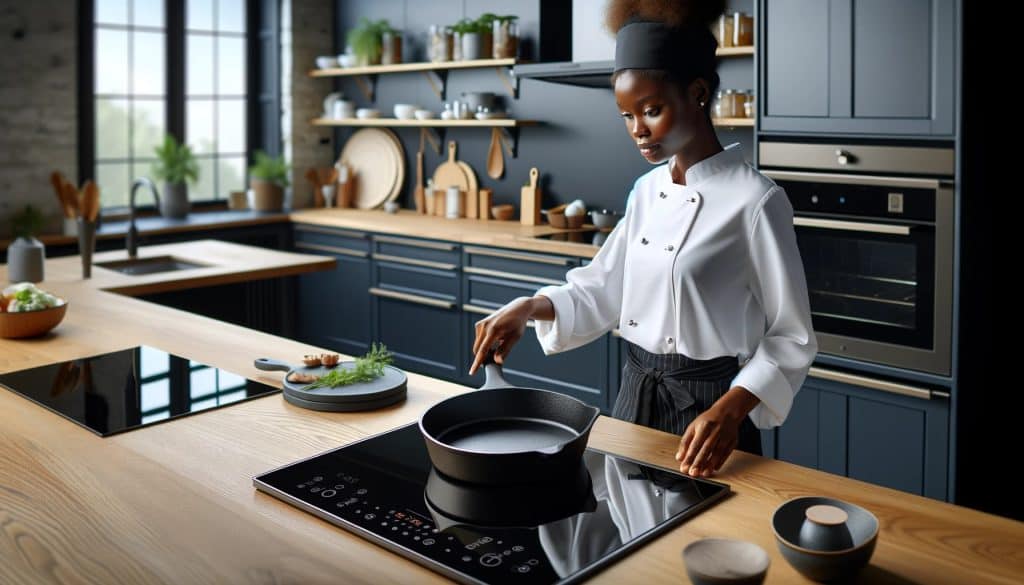
Rapid Heat Transfer for Quick Cooking
The standout feature of induction stoves is their ability to transfer heat rapidly. This is a game-changer for cooking with cast iron, as it significantly reduces the time it takes for the cookware to reach the desired temperature. Whether you’re searing meat or boiling water, the quick response of an induction stove can make your cooking process more efficient.
Induction Cooking Times for Common Cast Iron Dishes
| Dish Type | Cooking Time |
|---|---|
| Steak (searing) | 3-4 minutes |
| Vegetable stir-fry | 5-7 minutes |
| Water (boiling) | 1-2 minutes |
Energy Efficiency: Eco-Friendly and Cost-Effective
Induction stoves are not only fast but also incredibly energy-efficient. They use electromagnetic energy to directly heat the cookware, minimizing wasted heat. This efficiency is a big plus for eco-conscious cooks looking to reduce their energy consumption and carbon footprint.
List of Energy-Efficient Features:
- Direct heat transfer
- Reduced cooking times
- Lower energy consumption
The Sophistication of Modern Cooking
The sleek and modern design of induction stoves adds a touch of sophistication to any kitchen. They fit perfectly into contemporary kitchen designs and are often favored for their minimalist and stylish appearance.
This aesthetic appeal, combined with their advanced functionality, makes induction stoves a coveted item for modern homes.
< class="wp-block-separator has-alpha-channel-opacity"/>Selecting the Perfect Stove for Your Cast Iron Companion
When it comes to maximizing the potential of your cast iron cookware, choosing the right stove is crucial. Each type of stove – be it gas, electric, or induction – brings unique benefits to the table. Let’s break down what to consider when selecting the best stove for your cast iron pieces.

Considering Burner Size and Configuration
The size and configuration of the stove’s burners are paramount. It’s essential to match the burner size with your cast iron cookware for optimal heat transfer. A mismatch can lead to uneven heating and subpar cooking results.
The configuration of the burners can impact your cooking efficiency, especially when multitasking or preparing multiple dishes at once.
Ideal Burner Size for Cast Iron Cookware
| Cookware Size | Recommended Burner Size |
|---|---|
| Small Skillet | Small to Medium Burner |
| Large Skillet | Large Burner |
| Dutch Oven | Medium to Large Burner |
Evaluating Heat Distribution and Control
Even heat distribution is a must for cooking with cast iron. It ensures consistent cooking results, which is especially important for delicate dishes. Precise temperature control allows for more nuanced cooking, giving you the flexibility to sear, simmer, and sauté to perfection.
List of Heat Control Features:
- Adjustable temperature settings
- Even heat spread across the cookware
- Quick response to temperature changes
Prioritizing Ease of Cleaning and Maintenance
Lastly, ease of cleaning and maintenance can’t be overlooked. Stoves with smooth, easy-to-clean surfaces save time and effort in the kitchen. Features like removable grates on gas stoves or the flat surfaces of electric and induction stoves can make the post-cooking cleanup much less of a chore.
< class="wp-block-separator has-alpha-channel-opacity"/>Caring for Your Cast Iron Cookware
Proper care and maintenance of cast iron cookware are essential to ensure its longevity and performance. The process of seasoning and regular, gentle cleaning are the cornerstones of keeping your cast iron in top shape.
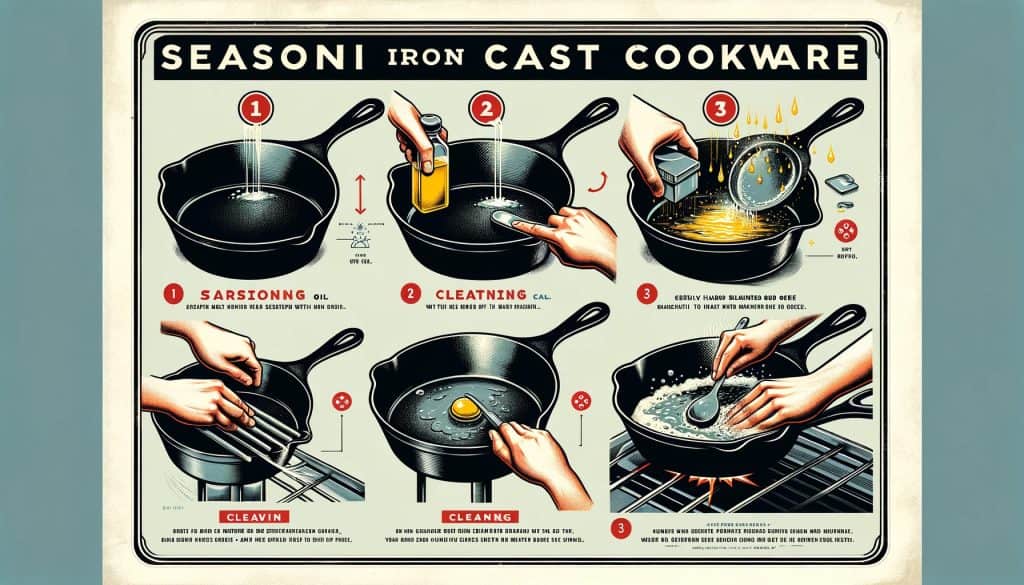
Proper Seasoning: The Key to Culinary Excellence
Seasoning is the process of applying a layer of oil to the cast iron and heating it, which creates a natural, non-stick coating. This not only enhances the performance of your cookware but also helps preserve the integrity and flavor of the food cooked in it. Seasoning forms a protective layer that prevents rust and ensures your cast iron gets better with age.
Steps for Seasoning Cast Iron:
- Clean the cookware thoroughly.
- Apply a thin layer of cooking oil evenly over the surface.
- Place it in a preheated oven at 375°F for about an hour.
- Let it cool before storing.
Cleaning and Maintenance: Essential for Longevity
Regular cleaning is crucial to maintain the quality of your cast iron cookware. The key is to clean it gently without damaging the seasoning. Hand-washing with warm water and a mild soap is recommended.
Harsh abrasives or detergents should be avoided as they can strip the seasoning and reduce the cookware’s non-stick qualities.
Tips for Cleaning Cast Iron:
- Use a non-abrasive sponge or brush.
- Dry it immediately after washing to prevent rust.
- Apply a light coat of oil after cleaning to maintain the seasoning.
FAQs: Mastering Cast Iron Cooking on Different Stoves
Navigating the use of cast iron cookware across various stovetops can be filled with questions. Here’s a quick guide to some of the most frequently asked questions to help you make the most of your cast iron cookware.
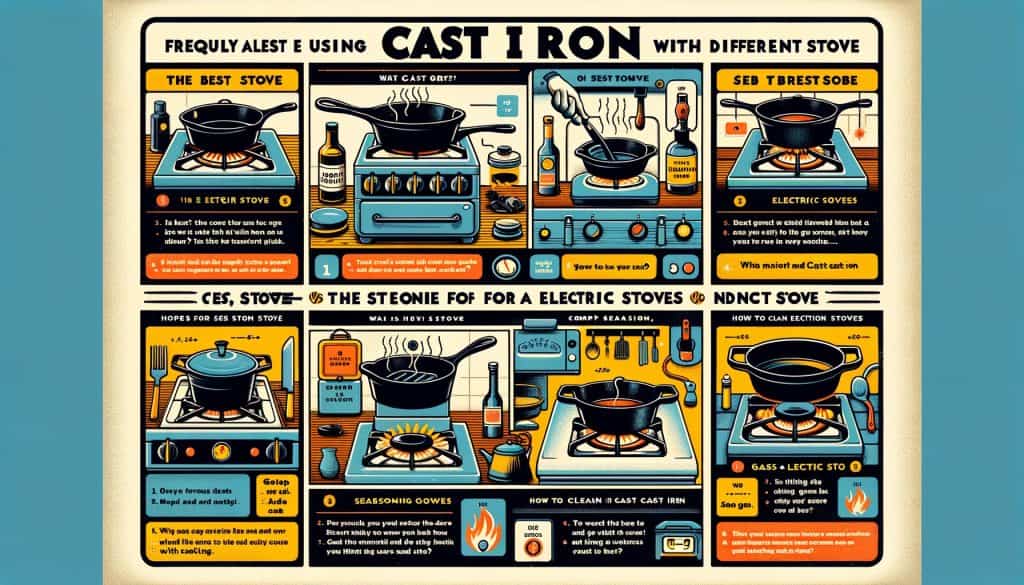
1. What is the best stove for searing cast iron?
For searing in cast iron, gas stoves are often considered the best. They provide high heat and allow for immediate temperature adjustments, which is essential for achieving a perfect sear.
2. How do I clean my cast iron cookware on an electric stove?
Cleaning cast iron on an electric stove is similar to other stoves. Let the cookware cool down, then wash by hand with warm water and mild soap. Avoid using metal scouring pads or harsh abrasives. Dry it immediately to prevent rust.
3. Can I use cast iron on an induction stove?
Yes, you can use cast iron on an induction stove. However, be careful when moving the cookware to prevent scratching the stove’s surface. Induction stoves are efficient and provide even heating, making them suitable for cast iron.
4. What is the difference between a gas and electric stove for cast iron?
The main difference lies in heat control and distribution. Gas stoves offer quick heat adjustments and are great for varying cooking techniques. Electric stoves provide consistent heat and are generally easier to clean and maintain.
5. How do I season my cast iron cookware?
To season cast iron, clean it first, then apply a thin layer of vegetable oil. Heat the cookware in an oven at 375°F for about an hour. Allow it to cool in the oven. This process creates a natural, non-stick coating.
Conclusion
These answers should help guide you in using and maintaining your cast iron cookware, regardless of the type of stove you have. Remember, the key to great cooking with cast iron is understanding how it interacts with your stove and how to care for it properly.
